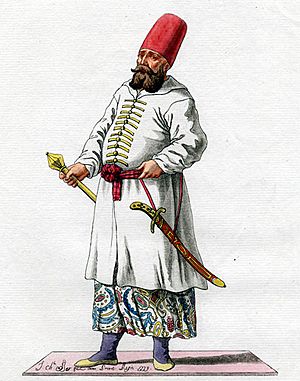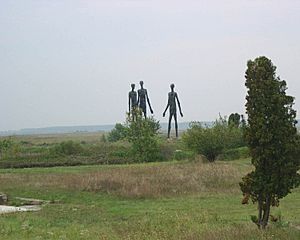Razzia (military) facts for kids
A razzia is a term for a surprise attack on an enemy settlement. Historically, these attacks aimed to get valuable items, capture people, expand territory, or scare enemies.
One famous razzia was the sack of Rome in 410 by the Visigothic king Alaric I. This event had a big impact and led to many more invasions in the years that followed.
Over time, the word "razzia" has also been used for other similar actions. These include police raids or violent attacks by organized groups, like those seen in Brazilian favelas or refugee camps during the war in Central Africa.
Today, in the Turkish language, the term "razzia" means "war veteran."
Contents
What Does "Razzia" Mean?
The word Ghazw or ghazah (Arabic: غزو) is an Arabic term meaning "battle". It is often used for battles fought for the cause of Allah (God). This word comes from the root g.z.w. which means "to attack."
- The word ghazwa was first used for battles where Muhammad himself took part. Later, it became linked to battles that helped spread Islam. A ghazi or "Warrior of the Faith" was someone who fought in these battles.
- In Western Europe, the term razzia comes from the French word razzier. This word entered French after the French took over Algeria. It is a French way of writing the Arabic word ghazya.
- In Medieval Spain, these raids were called aceifa. This word comes from the Arabic ṣáyfa, meaning "harvest" or "summer expedition."
Related Words
- akinji: This means "raider" and is a later word for ghāzī.
- ribāt: This was a fortified building used by a military group, especially in North Africa.
The Aceifas: Raids in Spain

In the Iberian Peninsula (modern-day Spain and Portugal), Muslim raids were called aceifas. This Arabic word al-ṣayfa means "Saracen war expedition that takes place in summer."
The name ṣayfa is linked to ṣayf (summer). It first meant "harvest" but later came to mean "military expedition." This was because goods were "harvested" (plundered) during these raids, which often happened in the summer.
The first major aceifas against Christian lands in Spain began after Bermudo I was defeated by the Andalusian leader Hisham I in 791. They even sacked the city of Oviedo in 794.
Later, Alfonso II the Chaste became king of Asturias. Christian forces then started their own raids, like the one against Lisbon in 798.
Internal problems in the emirate of Cordoba stopped the raids for a while. But when Abderraman II became ruler, he organized yearly aceifas against the Christians. Sometimes, he even launched three in one year! Most of these attacks were aimed at Alava and Galicia, which were the most vulnerable areas.
A rule in Islamic law stated how holy war should be fought:
The holy war must be carried out every year, with enough soldiers, towards the most exposed side. It is a duty for every free, adult, and able man to help, either by fighting or by providing goods.
Almanzor followed this rule very strictly. In 981, when Hisham II gave him power, Almanzor (whose title meant "The Victorious of God") organized up to five expeditions into Christian lands.
When Almanzor died in 1002, he had led 52 successful military campaigns against Christian kingdoms. Some of the most famous aceifas were against Barcelona (985) and Santiago de Compostela (997). Legend says he made Christian captives carry the bells of the cathedral all the way to Cordoba. Many Christian monasteries, Portuguese cities, and the capitals of the Christian kingdoms of Pamplona and León were also attacked. León was sacked four times.
During the rule of the Almoravids and Almohads, aceifas were directed at both Christian and Muslim lands. The Almoravids raided across North Africa, reaching as far as Ghana.
The last major aceifas in Spain happened shortly after the battle of Alarcos, in 1198 against Madrid and in 1199 against Guadalajara. The battle of Las Navas de Tolosa in 1212 finally broke the Almohad military power. After this, Al-Andalus (Muslim Spain) never went on the attack again.
Raiders: The "Ghazi"
Ghazi (Arabic: غازى) is an Arabic word from ghazā meaning "raided" or "waged war." It was adopted into other languages like Turkish to describe Muslims who swore to fight non-believers in the Islamic religion. It is similar to Mujahid, meaning "one who wages jihad" (holy war).
Al-Mansur (977-1002) created a military rule based on war successes, which became seen as holy war against Christians. He led over 50 razzias against Christian kingdoms. These raids aimed to get money, punish non-believers, and boost his own power. The destruction of Barcelona (985 AD) and Santiago (997 AD) were the most damaging.
For the ghāzīs on their marches, it was a religious duty to destroy the lands of non-believers who resisted Islam, and force them to surrender.
The ghāzī warrior existed at least since the Sasanian period. They were often mercenaries and fighters on the borders. Later, many ghazi fought in the Indian campaigns of Mahmud of Gazni.

The ghāzī way of life involved taking plunder. So, in peaceful times, they sometimes became bandits or caused trouble. They formed groups that attracted adventurers, religious followers, and people who disagreed with the government or religion. Soldiers of Turkish background were common, especially after Mamluks (Turkish slaves) joined their ranks. Some of these ghāzī warriors rose to powerful military and political positions in various Muslim states.
In the west, Turkish ghāzīs regularly raided along the Byzantine border. They often met their match in the Greek and Armenian akritoi (border guards). After the battle of Manzikert, these raids became more intense. The ghāzī groups formed brotherhoods, similar to Christian military orders. They wore white caps and carried clubs as their symbols. These ghāzī groups grew stronger during the Mongol conquests, as many people fled to Anatolia from Persia and Turkestan.
These groups were not very strict in their organization, showing their popular nature. Ghāzī warriors could move up in rank by gaining respect with a particular amir (leader), much like the condottieri of Western mercenary groups. The Ottoman Empire grew from the land conquered in Anatolia during these ghazw (raids). It is said that its founder, Osman I, was a ghāzī inspired by Sheikh Ede Bali.
Later in Islamic history, the special title ghāzī was given to Muslim leaders who successfully expanded the borders of Islam. This title eventually became very exclusive, similar to how the Roman title Imperator became only for the supreme leader of the Roman state and his family.
The Ottomans were likely the first to do this. The practice of ghazw goes back to the very beginning of their state.
By the start of Ottoman rule, "Ghazi" had become a title of honor and meant "leader." In a 1337 inscription, Orhan, the second Ottoman ruler, is called "Sultan, son of the Sultan of the Gazis, Gazi son of Gazi, warlike lord of the horizons." The Ottoman poet Ahmedi, around 1402, described a Gazi as:
An instrument of the religion of God, a servant of God who cleanses the earth of polytheistic filth, the sword of God.
The first nine Ottoman leaders used "Ghazi" as part of their title, and often their successors did too. It never became a formal title like Sultan ul-Muyahidin, which Sultan Murad Khan II KhojāGhazi used.
Because this title gave political power, Muslim leaders competed to be the best ghāziya. The Ottoman sultans were generally seen as better than the rest:
For political reasons, the Ottoman sultans, who were also the last caliphs, greatly valued their reputation as ghāzīs in the Muslim world. After winning battles in the Balkans, they would send reports (called feth-nāme) along with captives and loot to other Islamic rulers. Christian knights captured by Bāyezīd I after his victory at Nicopolis in 1399 were sent to Cairo, Baghdad, and Tabriz. They were shown in the streets, causing big pro-Ottoman celebrations.
The term Ghazi was also used as an honorific title, meaning "the Victorious," for high-ranking officers who did well against non-Muslim enemies. For example, General Osman Pasha received it after defending Plevna in Bulgaria. Mustafa Kemal Ataturk, a secular politician, was also given this title.
How Razzias Were Carried Out
When done as part of Islamic jihad, the purpose of a razzia was to weaken the enemy's defenses before a full conquest. Since a typical razzia was not large enough for big military goals, it usually involved surprise attacks on easy targets like villages. The goal was to scare and upset the people and destroy supplies that could help the enemy. Islamic rules clearly stated who should go to war and who was excused.
Sick people, children, those with mental illness, blind and lame people, women, individuals without enough money for war (weapons, horses, supplies), slaves, and people in debt were excused from holy war. Also, those whose parents (or one parent) did not allow them to go were excused. However, a grandfather's refusal was not enough to stop someone from going.
While Islamic war rules generally forbade killing non-fighters like women, monks, and serfs, it was allowed to take or destroy their property and make them slaves.
Non-believers would be asked to accept Islam. If they did not agree after three days, they would be asked to pay a special tax (yizya). If they refused, then they could be fought and destroyed, except for women (unless they fought against Muslims), children, the mentally ill, the elderly, the physically disabled, the blind, and monks living in convents or hermitages. All those whom the law said should be spared would be left with what they needed to live.
The only way to avoid these attacks was to submit to the Islamic state. If non-Muslims did this, they gained the status of dhimmi-s, meaning they lived under the state's protection. Many Christian sources sometimes mix up these two phases of Ottoman conquests. Faced with the threat of the ghāzīs, people living near the Empire's borders often gave up on the weak protection of Christian states. They found safety by joining the Ottoman Empire. This way, farmers living in the countryside often gained more than they lost.
In non-believer lands, the leader can apply legal punishments. One can destroy homes, cut and burn trees, if it harms the non-believers or if there is no hope of keeping the land. Destruction is then advised, but it is advised to stop if there is hope of keeping the land.
One of the main sources that tell us about how traditional razzias happened are medieval Islamic legal scholars. Their discussions about what was allowed and not allowed in war actions show some of the practices of this institution. One important scholar was Averroes from Andalusia, in his work Bida-yat al-Mujtahid wa-Niha-yat al-Muqtasid.
"Maghāzī" Raids in Literature
Maghāzī literally means "campaigns." In Islamic literature, this term often refers to the military campaigns led by the Prophet Muhammad after the Hijrah (his move to Medina). The stories of these campaigns, often shown as defensive actions or attacks against invaders, which included traditional plunder, form their own type of prophetic biography within Islamic literature. A famous example is al-Waqidi's Maghāzī.
Modern Uses of "Razzia"
World War II
Some well-known razzias from this time include the Night of the Long Knives or the Night of Broken Glass, carried out by the Gestapo in Germany. The SS raid on the Yugoslav city of Žabalj (now in Serbia) and in occupied Denmark are also called razzias.
Chechnya
During the Second Chechen War, Chechnya announced a gazawat (holy war) against Russia. This was done to gain support from the mostly Islamic population in the country.
Other Examples
Other current examples of razzias include raids by death squads in Brazilian favelas. Also, paramilitary attacks during the war in Central Africa are considered razzias. The many attacks by Colombian guerrilla groups on the Colombian army and vice versa could also be seen as razzias.
See also
 In Spanish: Razia para niños
In Spanish: Razia para niños



